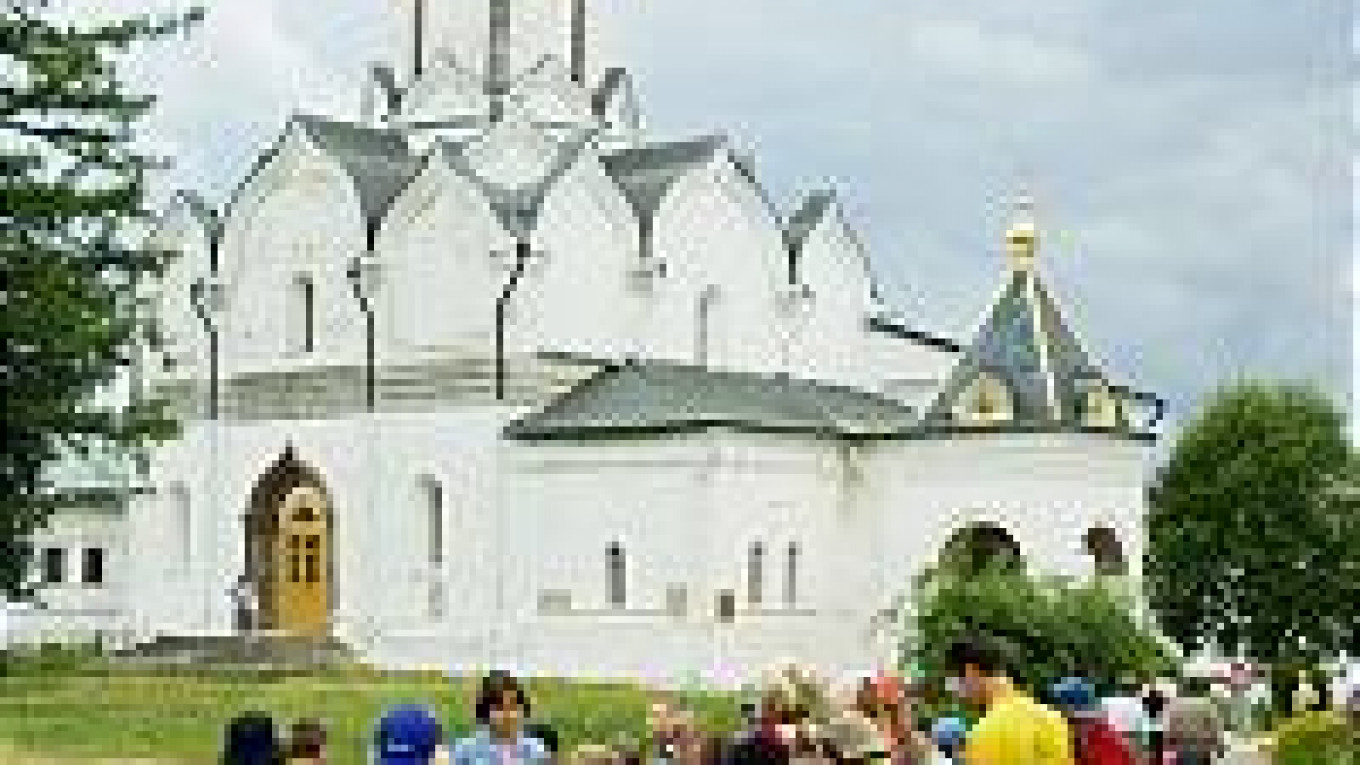Zvenigorod was founded in the 12th century on the bluffs overlooking the Moscow River, and soon became an integral part of the fledgling Muscovite state. The town defended Muscovy first from the Golden Horde and later from Lithuanian and Polish invaders.
From 1328 to 1492, Zvenigorod was the center of an independent principality, though the local princes lived in Moscow (as many regional governors do today). The first written mention of Zvenigorod appeared in 1339 in the will of Ivan Kalita, prince of Muscovy and Vladimir.
Zvenigorod enjoyed a golden age during the reign of prince Yury Zvenigorodsky, from 1389-1434. Construction of the town?€™s white stone churches began at this time. The town enjoyed another building boom during the reign of Tsar Alexei Mikhailovich Romanov (1645-76). Alexei loved to visit Zvenigorod and was a frequent guest at the nearby Savvino Storozhevsky Monastery.
Zvenigorod boasts some of the finest early Moscow architecture anywhere. Inside the citadel (known locally as the gorodok, or little city), an earth fortification towering 46 meters above the Moscow River, stands the spectacular Cathedral of the Assumption, built in 1399. The cathedral has survived for the most part in its original form: rectangular walls with one dome and three apses on its east-facing side. The small belfry in front of the cathedral dates from the 1840s.
The Savvino Storozhevsky Monastery complex as we know it today was formed in the mid-17th century. Like the citadel 1.5 kilometers away, it originally served as a defense post. Lithuanian forces besieged the town three times in short succession in the early 17th century, sacking the monastery. In 1652 the monastery gained in notoriety when its founder, the monk Savva Storozhevsky, was canonized. St. Savva?€™s relics were placed in the monastery?€™s Nativity of the Virgin Cathedral. During the 1682 Streltsy rebellion, Tsarina Natalya Kirilovna took shelter in the monastery along with her daughter Sofiya and her sons, the future Ivan V and Peter the Great.
The Nativity of the Virgin Cathedral, built in 1405, is the monastery?€™s most ancient building. Its basic structure is similar to the Cathedral of the Assumption in the citadel, though its decoration is far more lavish. The icons on the altar barrier were painted by Andrei Rublyov, founder of the Moscow school of painting. Three of those icons ?€” the so-called Zvenigorodsky Chin, including icons of the Apostle Paul, the Savior and the Archangel Michael ?€” are now housed in Moscow?€™s Tretyakov Gallery. The frescoes on the church?€™s walls and vaults were painted in the mid-17th century by the royal studio headed by Stepan Ryazantsev. The iconostasis was also painted in the 17th century.
Under Tsar Alexei Mikhailovich the external stone wall of Savvino Storozhevsky Monastery was built in the 1650s, as was the Church of the Trinity, near the northern entrance. This church was much changed over the years. The monastery?€™s refectory was built in 1652-54. It was comprised on three levels: a cellar for wine and food storage; the first floor with a kitchen and servants?€™ quarters; and a second floor housing the refectory itself and the monastery?€™s treasury. The top floor collapsed in 1806, however, leaving the one-story building that stands today. The monastery?€™s most recent church, the Church of the Transfiguration, dates from 1693.
The tsar?€™s palace was built at the same time on the former site of the monks?€™ wooden cells. Originally this large one-story building had eleven suites of rooms that housed the tsar?€™s retinue of some 100 on his visits to Zvenigorod. The chronicles record that the portraits of all of Russia?€™s tsars and grand princes, including Ivan the Terrible, hung on the walls. In 1742 the palace burned down. A seminary was installed here after reconstruction in 1775.
After the imperial capital was moved north to St. Petersburg in the 18th century, Zvenigorod became a quiet provincial town. That peace was broken during Napoleon?€™s invasion in 1812. A French general and his troops were quartered in Savvino Storozhevsky Monastery, from which they carried off a great number of precious objects.
In the 19th century, sleepy Zvenigorod lay far from major trade routes and railroad lines. Its countryside earned it the nickname ?€?Switzerland near Moscow,?€? and its charm attracted many famous artists, including the writers Anton Chekhov and Maxim Gorky, the painters Isaak Levitan and Ilya Repin, and singer Fyodor Chaliapin and composer Pyotr Tchaikovsky. Chekhov, a doctor by profession, worked in the local hospital and found material for several stories. A bust of the writer was placed before the hospital in 1954.
To learn more about Zvenigorod, visit the town?€™s (Russian-language) web site at www.zvenigorod.ru
A Message from The Moscow Times:
Dear readers,
We are facing unprecedented challenges. Russia's Prosecutor General's Office has designated The Moscow Times as an "undesirable" organization, criminalizing our work and putting our staff at risk of prosecution. This follows our earlier unjust labeling as a "foreign agent."
These actions are direct attempts to silence independent journalism in Russia. The authorities claim our work "discredits the decisions of the Russian leadership." We see things differently: we strive to provide accurate, unbiased reporting on Russia.
We, the journalists of The Moscow Times, refuse to be silenced. But to continue our work, we need your help.
Your support, no matter how small, makes a world of difference. If you can, please support us monthly starting from just $2. It's quick to set up, and every contribution makes a significant impact.
By supporting The Moscow Times, you're defending open, independent journalism in the face of repression. Thank you for standing with us.
Remind me later.


